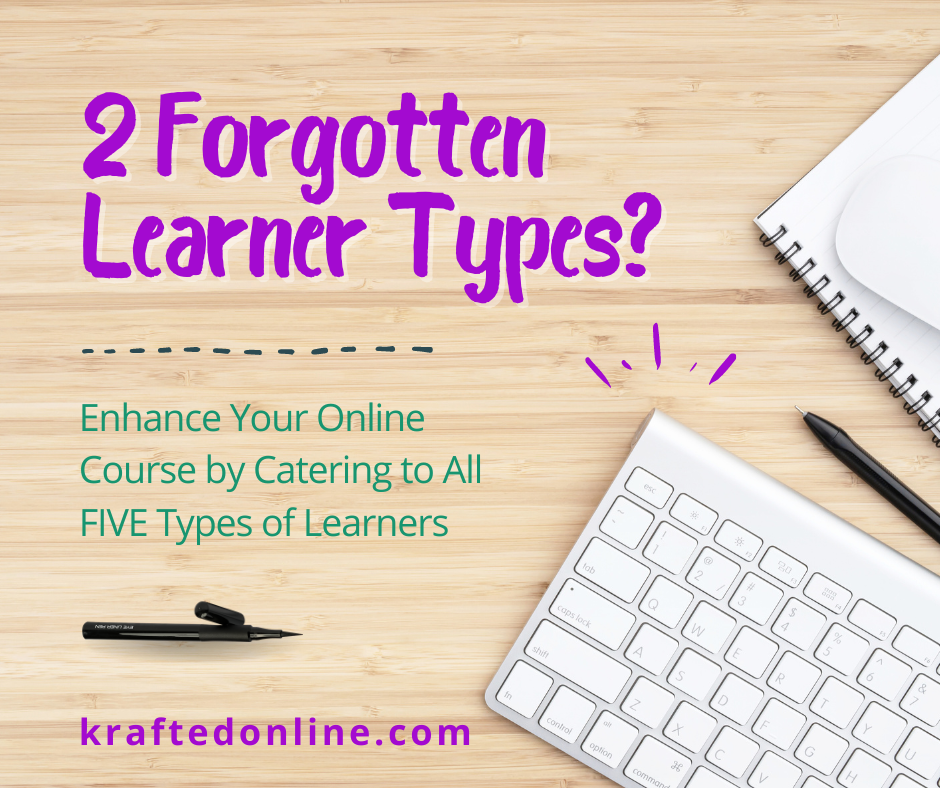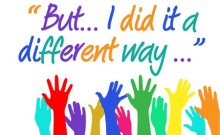
Pay attention to how your students learn to have a better chance at changing their lives… and creating repeat buyers.
Square block… round hole.
Clang… clang… clang…
Hmm… have you ever had a learner who just. didn’t. get. it?
No matter how you rephrase, redraw, or re-contextualize… the ideas just won’t sink in.
Ah, yes. This is definitely a problem.
When you pay attention to how your students internalize the ideas in your online course…
You’ll have a much better chance of changing lives, creating sparks of inspiration, and earning a repeat student, follower, or buyer.
So, back to the issue at hand…
Clang… clang… clang…
When the teaching methods used in your online course don’t align with your students’ personal learning styles, they’ll have harder time staying engaged and finding success with your course.
That’s why instruction designers think about the three types of learners — and how we can build courses to work for each of their needs.
Maybe you’ve heard of these learning styles before?
Visual, auditory, and kinesthetic…
But is that the end of the story?
Maybe not.
We actually need to consider two more types of learning styles and how they can influence the success of your online course.
I’ll get to that in a sec…
First, let’s review the three classic styles and what you can do in your online course to connect with these folks.
Seeing is Believing: The World Through a Visual Learner’s Eyes
Let’s start with one that’s easy… well, easy on the eyes, at any rate.
–> A visual learner is someone who learns best when ideas are presented in a visual format.
In terms of your online course, this is something who loves studying those graphs, charts, diagrams, and images sprinkled across your slides or shared screen moments.
They do best when they see ideas written in words or illustrated in a graphic way.
–> Personally, I am a visual learner. So, when I recall information, I literally have to picture the moment I learned an idea in my mind, or visualize where I read it. Then, I “re-read” to recall information. When I spell words, I imagine a chalkboard where the letters are being written before my mind’s eye.
On the flip side, if someone gives me directions for how to get to the downtown store, I’m usually lost by the time they’ve mentioned “the second right onto main street.” Umm… can you say that again?
When building your course, follow some of these best practices to help visual learners…
- Include visually appealing slides and graphics in presentations.
- Provide diagrams, charts, and infographics to illustrate key concepts.
- Use videos and animations to demonstrate processes or concepts.
- Offer transcripts or captions for multimedia content.
Sonic Scholars: How Auditory Learners Turn Learning into an Audio Experience
Speaking of driving directions…
Someone who is an auditory learner would have a much easier time understanding and remembering.
“Take the second right onto Main Street… up the hill… past the pet store… left on Darlene Street… and look for the big red sign.”
Easy!
–> An auditory learner is someone who learns best through listening.
This is someone who prefers spoken explanations, discussions, and other auditory stimuli.
In your online course, this is the person who can easily listen to an idea being explained — without visual aids — and understand what you are trying to say.
You can accommodate auditory learners by…
- Incorporate audio elements such as narrated presentations, podcasts, or interviews.
- Provide clear and concise spoken explanations for key concepts.
- Include discussions or forums where learners can engage in verbal exchanges.
- Offer opportunities for reflection and verbalizing thoughts.
Hands-On Heroes: How Kinesthetic Learner Types Embrace the Art of Learning by Doing
Some people might do okay if they hear a concept, or see a concept in action… but what they really need is to feel the experience of interacting with that idea.
They want to move their bodies and manipulate objects in their hands.
–> A kinesthetic learner is someone how learns best through hands-on experiences, physical movement, and interaction with their environment.
Any learning experience that allows them to touch things or move their body will help them internalize new information.
For me, that means I have to write things down as I learn them. I take notes, make lists, and like to try new skills before I feel confident they sunk in.
Help kinesthetic learners in your online course by doing the following…
- Provided guided notes or workbooks where they can write out their ideas and work through problems with their hands.
- Integrate interactive elements such as quizzes, simulations, or virtual labs.
- Encourage learners to apply knowledge through practical exercises or real-world projects.
- Provide opportunities for physical movement, such as breaks or kinesthetic activities.
- Incorporate hands-on learning experiences, even in a digital environment.
From Solitary Reflection to Social Engagement
So, now that we’ve got the three classical learning styles covered…
What are some other learning styles that will influence how much — or how little — a student is able to take away from your online course?
What about those two forgotten learning styles I mentioned?
Sounds intriguing, right?
Some people I know… (definitely not me…)
… become absolutely exhausted when a course or seminar or workshop requires them to be in a social situation.
Video calls, in-person discussions, group activities…
Yikes!
Sure, these live experiences can be amazing and meaningful, but they also go directly against their very nature.
These are the folks who would feel much more comfortable, energized, and in control if they were at home, with a blanket, and some learning material.
Break out the colored highlighters and hot tea… it’s time to learn!
(Again, I’m totally not talking about myself here.)
So, yes… the very idea of whether a learner is introverted or extroverted plays a huge role in how your learners are able to experience an online course.
Consider this…
–> An introverted learner is someone who prefers solitude and opportunities for introspection. They feel energized by spending time alone to process information.
On, the other hand…
—> An extroverted learner is energized by social interaction. They thrive in group settings and enjoy collaborating on activities and discussions.
So, think about your online learning experience…
Is the content focused on self-paced content they work through on their own?
And have you provided enough opportunities for students to gather in a social situation, having discussions, asking live questions, and working through their problems.
I’d argue that any online course should have the following elements to support their introverted audience members…
- Give students an opportunity to express themselves through written rather than verbal communication.
- In group settings, give introverted learners the space to sit back and observe. They will participate in their own time.
- Give them a way to learn in a self-paced, independent way where they have the freedom to explore and think about concepts at their own pace.
Then, for extroverted learners, include the following…
- Let extroverted learners share ideas through verbal communication rather than just through writing. Let them articulate their thoughts and ideas on video calls or within in-person workshops.
- Recognize that extroverted learners may prefer to discuss their ideas with others in order to clarify their understanding. They literally think out loud in order to process information.
- Give extroverts an opportunity to participate in group discussions through online video calls or an in-person workshop.
The Balancing Act: Cater to All FIVE Learner Types of a Successful Online Course
Leave behind the old idea of just three types of learners…
And embrace these how these five types of learners can impact your online course.
(And, oh yeah… just to keep things spicy… one learner can fit into more than one category.)
When you design your online course with all learner types in mind, you have a much better chance of creating an enjoyable — and meaningful — experience for everyone.
And that leads to a successful business and more opportunities to spread your message!







Leave a Comment
You must be logged in to post a comment.